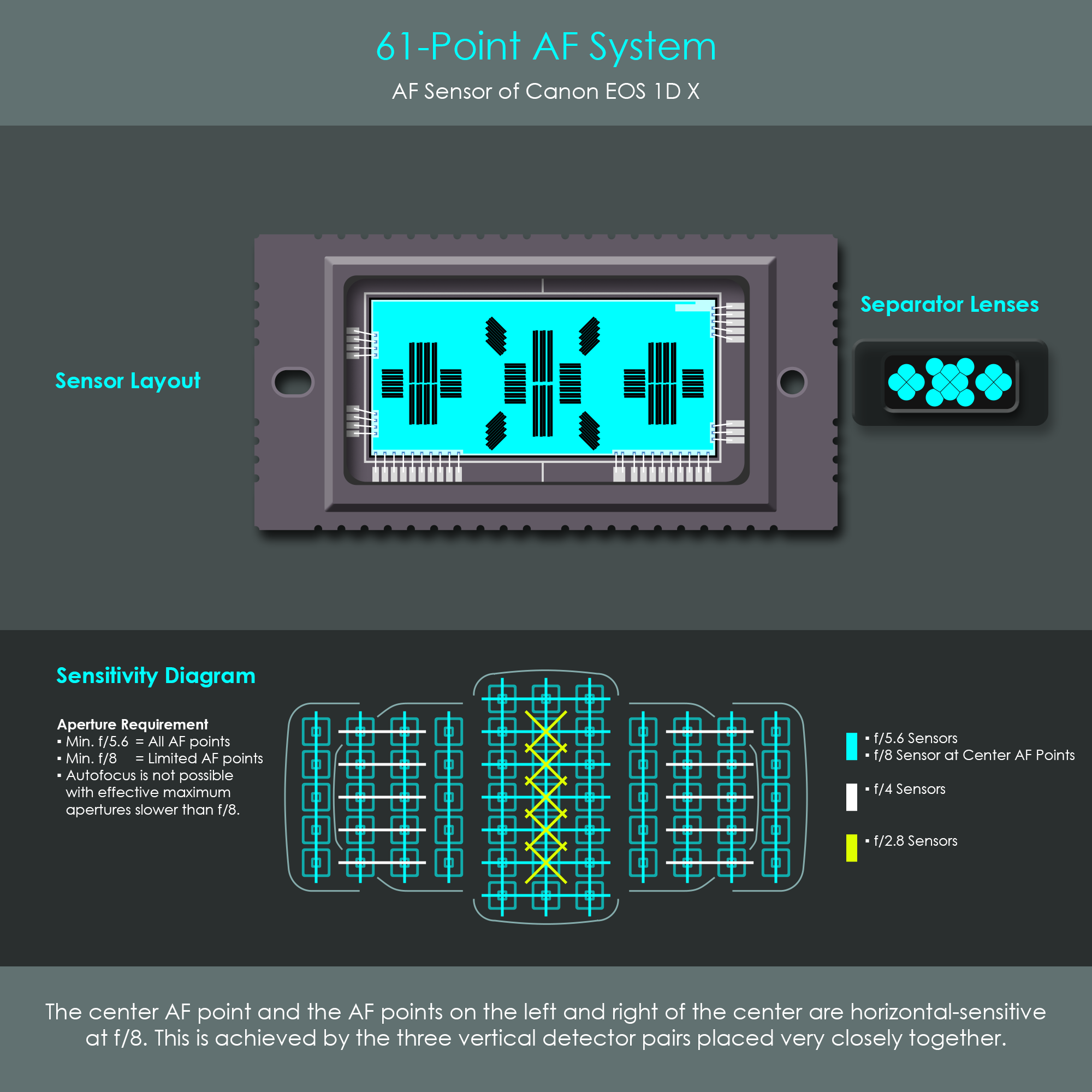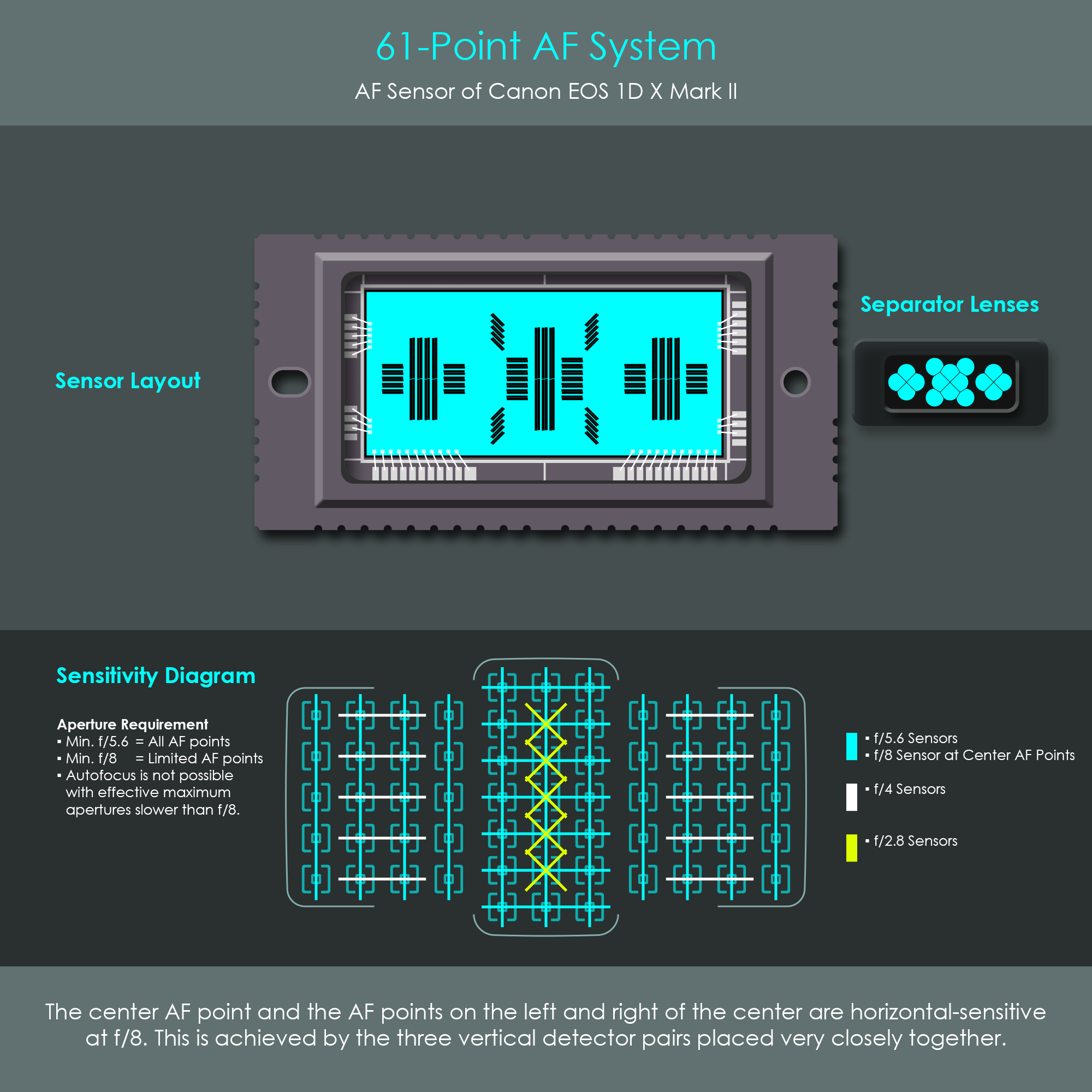
An illustrated chronological story about how Canon autofocus systems and viewfinders went from a single AF point (1987) to 191 AF points (2020).
The number of AF points was increased, resulting in a 61-point AF system. This system offers an increased accuracy not just for the center AF point but for all available AF points. Canon calls this 1st generation their High Density Reticular AF.
Each AF sensor is indicated with small rectangular frames. AF points are arranged in three large zones. On this 1st generation design, AF points are very densely packed with very small vertical spacing. The illustration shows the viewfinder coverage offered by a full frame camera.
The sensor chip is inside a ceramic package with a glass cover placed over the active area. One major innovation is the application of a dual-line zig zag arrangement to all of the detector stripes (vertical, horizontal, and diagonal ones) in all three zones. In addition, the detector's pixel pitch has been increased to improve AF accuracy even more.

Depending on the lens attached to the camera, the number of usable AF points, AF point patterns or the types of AF sensors may vary.
If a lens with a maximum aperture of f/2.8 or faster is attached to the camera, 41 AF points are standard-precision cross-type detectors, and 20 AF points in the outer zones are standard-precision vertical detectors. Out of the 41 cross-type sensors, five vertically arranged AF points in the center are high-precision dual cross-type detectors.
When a lens having a maximum aperture of f/4 is used, the 41 AF points remain standard-precision cross-type detectors and the 20 AF points remain standard-precision vertical detectors. However, the five high-precision dual cross-type detectors turn into regular standard-precision cross-type detectors.
When a lens having a maximum aperture of f/5.6 is used, all 21 AF points in the center zone remain standard-precision cross-type detectors but all 20 cross-type AF points from the two outer zones turn into standard-precision vertical detectors, resulting in 40 vertical sensors in the outer zones.
For the center AF point, standard-precision cross-type AF detection is even possible with lens and extender combinations having an effective maximum aperture as small as f/8. In addition, four AF points adjacent to the center AF point do also work at an effective maximum aperture of f/8. The two AF points to the left and right of the center are standard-precision vertical detectors and the two AF points above and below the center are standard-precision horizontal detectors. Autofocus is not possible during viewfinder shooting with effective maximum apertures slower than f/8.
The system has an AF working range of EV -2 - 18 (with the center AF point supporting f/2.8) at ISO 100.
Compared to the previous 61-point AF system, the number of f/8 compatible points was drastically increased. This 2nd generation AF system can autofocus with all 61 AF points when using a lens and extender combination having an effective maximum aperture of f/8, with up to 21 of those points being cross-type. This is a significant upgrade from the 1st generation, which only allowed the center AF point with surrounding AF points to autofocus at f/8. Canon calls this 2nd generation their High Density Reticular AF II.
Note how the AF points are slightly expanded vertically. This has slightly increased the viewfinder coverage that this 2nd generation system offers compared to the 1st generation.
The sensor chip is inside a ceramic package with a glass cover placed over the active area. Again, all detector stripes of all three zones use the dual-line zig zag design. The detectors again use the increased pixel pitch to improve AF accuracy even more. On closer inspection, it can be seen that the vertical pairs of detector stripes have been moved closer together than on the 1st generation chip.

Depending on the lens attached to the camera, the number of usable AF points, AF point patterns or the types of AF sensors may vary.
If a lens with a maximum aperture of f/2.8 or faster is attached to the camera, 41 AF points are standard-precision cross-type detectors, and 20 AF points in the outer zones are standard-precision vertical detectors. Out of the 41 cross-type sensors, five vertically arranged AF points in the center are high-precision dual cross-type detectors.
When a lens having a maximum aperture of f/4 is used, the 41 AF points remain standard-precision cross-type detectors and the 20 AF points remain standard-precision vertical detectors. However, the five high-precision dual cross-type detectors turn into regular standard-precision cross-type detectors.
When a lens having a maximum aperture of f/5.6 is used, all 21 AF points in the center zone remain standard-precision cross-type detectors but all 20 cross-type AF points from the two outer zones turn into standard-precision vertical detectors, resulting in 40 vertical sensors in the outer zones.
One significant feature of this AF system is that even with lens and extender combinations having an effective maximum aperture as small as f/8, the same 21 AF points in the center zone remain standard-precision cross-type detectors and 40 AF points from the two outer zones remain standard-precision vertical detectors (as if an f/5.6 lens was used). Autofocus is not possible during viewfinder shooting with effective maximum apertures slower than f/8.
The system has an AF working range of EV -3 - 18 (with the center AF point supporting f/2.8) at ISO 100.